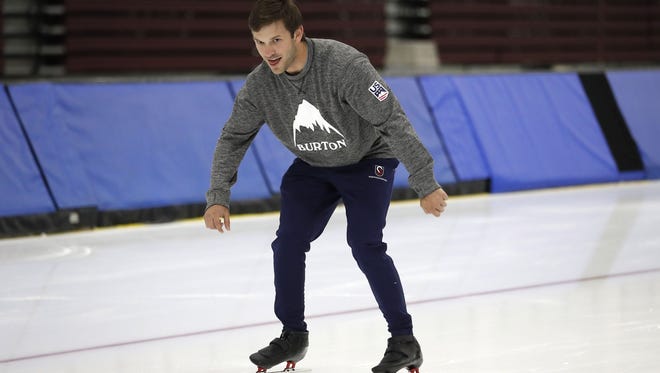NASCAR teams train with U.S. Winter Olympic athletes, find common ground

KEARNS, Utah -- The workout in the expansive gym at the U.S. Ski and Snowboard Association’s Center of Excellence was exhausting. The sensory overload of the downhill ski simulator was a rush. The trampoline room was a thrill, especially when Daniel Suarez finally landed that back flip. The bobsled run on a concrete track was exhilarating, and standing atop the ski jump venue was on the edge of terrifying and fascinating.
Later, in a side room at the Utah Olympic Oval, a two-day immersion event between a group of Toyota NASCAR drivers and crew chiefs and members of the U.S. Olympic ski and speedskating teams had transformed from a unique existence to a genuine shared experience. Left turns and drafting were incidental similarities on a promotional junket in part underscoring the car manufacturer’s partnership with the 2018 Pyeongchang Winter Olympics. This was where the rubber met the road and the metal met the ice.
A chunky boombox and several tables of metal-working equipment used to bend and sharpen the flat blades filled the utilitarian space. Skate technician Chris Needham explained to Furniture Row Racing drivers Martin Truex Jr. and Erik Jones, crew chiefs Cole Pearn and Chris Gayle and Joe Gibbs Racing driver Suarez how blades were affixed to the bottom of custom-molded skates slightly askew to maximize power and speed. Pearn and Gayle edged forward, and Truex nodded.
“The same way they tune the skates is kind of how we try to help the car. It was interesting when they talked about the curvature in the blade and how they change the curvature for the radius of (the) ice skating track,” Gayle told USA TODAY Sports during the recent visit.
“It’s kind of a similar thing we would do with stagger. I think it’s some of the same physics principles at work. But they just have to do it a little differently. It was interesting.”

Most of the drivers and crew chiefs began the day at the oval using an upended bucket for support as they adapted to the nuances of speed skates. Pearn, a winter sports enthusiast, adjusted quickly and bucketlessly. Gliding alone around the massive oval, he had time to formulate how tools used in NASCAR could improve speedskating.
“Dartfish,” he said, naming the video analysis program widely used in NASCAR to compare car performance. “I think as far as speedskating goes, especially in long track, I think it would be interesting to see accelerometer data, understanding, like, track profile and track lines and stuff like that. I think stuff we do for simulation ... would be pretty interesting for them to be able to try and find the last little bits of speed that you’re looking for.”
The skaters have used it, but U.S. mass start skater Joey Mantia says the team uses a more primitive system for simplicity. Pearn probably will come up with a few more suggestions.
But the trip wasn’t all business. Wedged on a Tuesday and Wednesday between Monster Energy NASCAR Cup Series races at Michigan International Speedway and Sonoma Raceway, it provided five competitors a chance to step outside their bubble amid a busy season. For Pearn and Suarez, it provided a chance for them to demonstrate innate athleticism on a new stage and find a common experience.
“We all share something similar. That something is competition,” Suarez said of mingling with Olympians. “We like to be good in whatever we do.”
MORE COVERAGE:
Super Bowl winning coordinator will drive pace car at New Hampshire NASCAR race
Richard Petty turns 80, still in NASCAR's fast lane
How Dale Earnhardt Jr. became one of NASCAR's top job creators
Pearn had a changing-for-gym-class urgency about him when he left the Center of Excellence locker facility to participate with the ski team. A Canadian smitten with winter sports, he was in his element. A rec league hockey player in Denver, Furniture Row’s home, and a frequent skier, Pearn proved a quick study on the simulator — where ski boots are slotted onto rails set in front of an immersive set of large video screens.
He later watched from a distance as his driver, Truex, slowly slalomed to confidence on a snowboard setup. Pearn remarked the next day at the speedskating oval that his driver had done well to graduate from pushing a bucket around the ice for balance to gliding along alone.
“Generally, from what I’ve seen, he’s not terribly coordinated,” Pearn said with a chuckle. “But he’s doing well.”
Suarez, raised in Monterrey, Mexico, was far less steeped in Nordic athletic culture, but his athleticism soon had him up to speed. A large side room, nicknamed “Ramps and Tramps” because it housed a skateboarding facility and two large trampolines, proved to be his playground. He became fascinated with launching himself into the air and eventually end over end into a backflip that coincidentally mimicked the victory celebration of his predecessor in the No. 19 Toyota, Carl Edwards. Finally nailing the stunt with the help of Olympic freestyle skiers had the group grinning into the evening in Park City.
After meeting the Olympians, Gayle said he appreciated that he and Jones have the opportunity to atone quickly for a disappointing race — or continue momentum from a good one — usually one week later.
“They train five to six hours a day, seven days a week, and hope to get paid in four years,” he said. “They’ve got to wait four years — and all the work has to be on the front side, and you’re not quite sure you’re going to make it — and actually get paid for the previous work you did. That’s got to be difficult.”
Follow James on Twitter @brantjames
